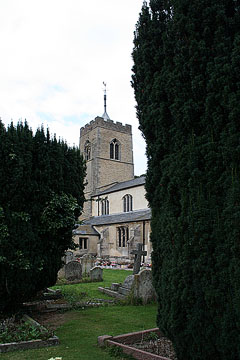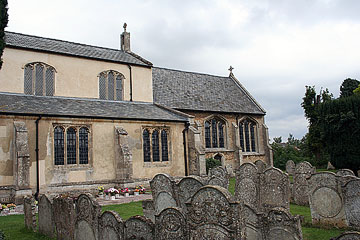St Mary reminded me of nothing so much as one of the flat barges used to travel around the shallow fen waterways. It is actually quite a big church: broad, with two aisles, and long. However, it has a flattened-out look. The aisle walls cannot be more than about ten feet high, and the clerestory is even shorter. The walls are stuccoed in a sunny beige colour, and the windows are classic late Perpendicular. Those in the aisles are square-topped with three mullioned lights each, and those in the clerestory have arches so flattened as to be nearly square-topped themselves. There is even a little sanctus bell-turret, which I suppose could serve as a chimney or whistle for the barge as it sails through the waterlogged fields.
At the west end, the 14 th century tower is also compact, though here the comparison with a barge must end, since barges rarely come with towers attached. It is very square, and built of yellow stone, with cross-buttresses and brick battlements.
The west front is a lesson in the dramatic effect that good proportions can have on a building, because my first impression was that it was large and grand. Closer inspection showed that the deeply framed doorway was actually rather small, and that the Perpendicular window above it wasn’t as big as it seemed, but the effect is still surprising and good.
Sadly, we weren’t able to get inside the church: there was no keyholder listed, and while we tried to get a key from the Rectory, there was nobody at home. So, a return visit is called for. Until then, what was I able to glean from peering in through the windows?
Well, the nave arcades are, like the tower, from the 14 th century, though Pevsner says that they sit on Norman bases. As is to be expected, the aisle windows and the clerestory are from the 15 th century.
The porch was built in 1840, and the chancel was completely rebuilt, in the same yellowish stone as the tower, in 1872. (From the exterior, it’s quite a good rebuilding: the windows match the clerestory quite well, and the stonework on walls and buttresses has aged nicely). There were two more big restorations in 1894 and 1901, which swept the interior clear: peering through the windows, the wide nave is very bare indeed. It’s also quite light, because (aside from the clerestory, which is glazed in a horrid shade of mustard yellow) the windows are all clear. They seem also to contain an interesting collection of reset fragments of medieval and renaissance painted glass: an indication of the hobby of a previous vicar, no doubt. Hopefully, we’ll be able to get inside next time, and have a closer look.
St Mary is kept locked, with no information about keyholders.

